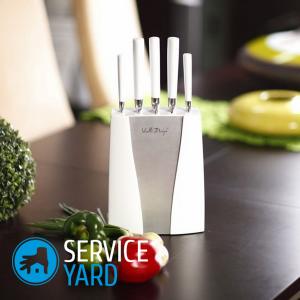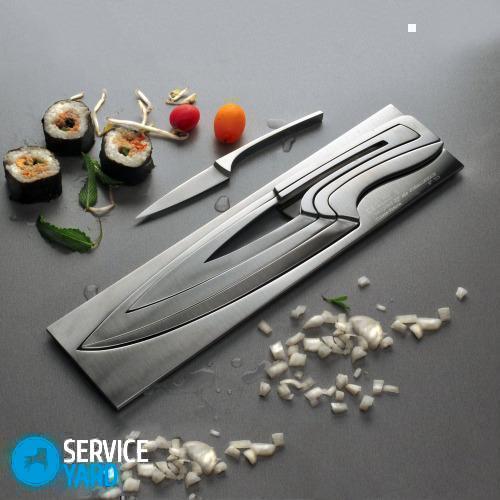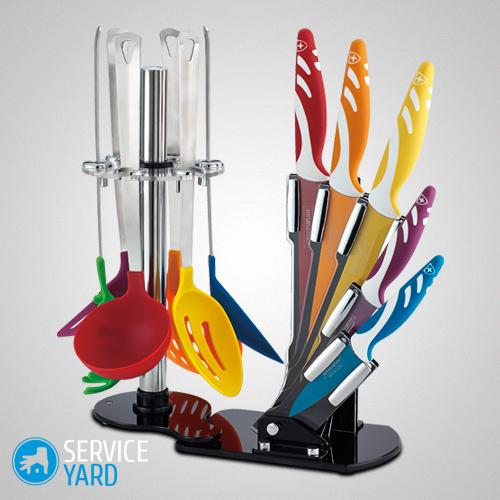Knife Sharpener

Any sharpening of a knife serves one purpose - to sharpen the blade so that the work with the blade is of high quality. You can grind the tool, of course, using the manual antiquated method, but it is much more pleasant and convenient to use a knife sharpener. To make a tool for sharpening the strength of each home master. To do this, you only need to understand the principle of the device and correctly assemble the parts.
to contents ↑Do-it-yourself knife sharpener
The configuration of a homemade knife sharpener, as well as its details, can be different. But as a sample, it is better to take a device for sharpening blades, which have the following main elements:
- Rod with a handle.
- A device for clamping a stone for sharpening or blank with sandpaper.
- Base with knives retainers, a clamp, as well as a unit that adjusts the angle of sharpening, and a stand.
How to make a knife sharpener with your own hands?
 Making a sharpener with your own hands is not as difficult as it might seem at first glance. For this, it is only necessary to prepare spare parts and combine them into one design. You can do this according to the following algorithm.
Making a sharpener with your own hands is not as difficult as it might seem at first glance. For this, it is only necessary to prepare spare parts and combine them into one design. You can do this according to the following algorithm.
Step 1. Cutting the base
As a base, you can use a piece of plate from tektolite, 400 * 60 * 25 mm in size, although a regular board or MDF board lying around in the basement will be suitable.
Step 2. Preparing the rack
Drill one hole under the stand at the base. Later, an M8 threaded rod and a length of about 30-35 cm will be wrapped in this hole. Insert the hairpin into the drilled hole.
Step 3. We master the joint for the stud
- Connect the two plumbing couplings with a nut and washer.
- Slide the manufactured fixture, which acts as a hinge, onto the pin at the base of the sharpener.
- Secure the tool with nuts and washers.
When using a home-made sharpener by moving this hinge, we will adjust the angle of sharpening.
Step 4. Making grindstones
To create grinding stones you will need:
- Wooden beam (length 2 meters, width - 4 cm, thickness - 2 cm).
- Hairpin M12 80 cm long.
- Sandpaper with grit 220, 360, 600, 1000, 1500 grit.
- Metal-plastic pipe.
Proceed as follows:
- From a wooden beam, make blocks of about 25 cm. Glue a strip of sandpaper on each bar using PVA glue. In the absence of such, clerical glue is also suitable.
Important! On the reverse side of the bar, sign which sandpaper that you glued so as not to get confused during operation.
- From the same bar, make clamps for the bars with a step (2 cm) for the grindstone and a hole for the M12 pin.
- Slide the finished whetstone and clamps onto the M12 stud.
- Tighten the construction with nuts and washers.
- For the beam with the grindstone to ride in a hinge, put on it a pipe made of metal-plastic and also tighten with nuts.
Step 4. Making the clamping mechanism for the knife
In order for the blade to be securely attached to the knife sharpener during sharpening, it is necessary to assemble the clamping mechanism. For this purpose, use two steel plates.
At the base (on the opposite side of the inserted stud), drill 2 holes for the M6 clamping bolts to secure the knife fixing device.
Important! The blade mount can be made of any suitable metal plates with holes that are rigid enough not to bend when tightening the bolts.
 Do not tighten the bolts strongly, since the blade in such a tack will be held securely.Due to the slots in the plates and the twisting force, adjust the clamping of the wide or narrow blade.
Do not tighten the bolts strongly, since the blade in such a tack will be held securely.Due to the slots in the plates and the twisting force, adjust the clamping of the wide or narrow blade.
to contents ↑Important! Additional tips will help you make your knife sharpener more convenient and functional:
- Rubber feet can be glued so that the sharpener and knife do not leave anywhere during sharpening.
- In order to fix the fixture to the table, you can use a clamp, curved from a thick strong plate. Drill 3 holes in the plate for mounting to the base of the sharpener, as well as one hole for the pressure screw M6.
How does the manufactured sharpener work:
- Install and fix a home-made sharpener on a table (you can use a clamp).
- Secure the blade with bolts and plates.
- Insert the free end of the bar into the guide ring on the stand.
- Put the desired template on the blade of the knife, and on top attach the selected whetstone (whetstone with sandpaper).
- Adjust the angle of the grindstone by raising or lowering the assembly, with guide rings, on the stand.
- After selecting the tilt, fix the ring with the upper nut.
- The movement of the rod when sharpening the blade should be smooth, away from you, with the shift of the grindstone to the side from the base of the blade to the tip.
to contents ↑Important! Blade sharpening angles should be:
- for soft products - 15-20 °;
- for kitchen appliances - 20-25 °;
- for universal blades (for outdoor recreation) - 25-30 °;
- for a chopping tool - more than 45°.
Stock footage
Manual sharpening of knives is considered more preferable than automatic, since after such processing the cutting edge is less susceptible to wear. We hope that a do-it-yourself knife sharpener will last you a long time, save money on the purchase of store devices and will do its job well.
- How to choose a vacuum cleaner taking into account the characteristics of the house and coatings?
- What to look for when choosing a water delivery
- How to quickly create comfort at home - tips for housewives
- How to choose the perfect TV - useful tips
- What to look for when choosing blinds
- What should be running shoes?
- What useful things can you buy in a hardware store
- Iphone 11 pro max review
- Than iPhone is better than Android smartphones



